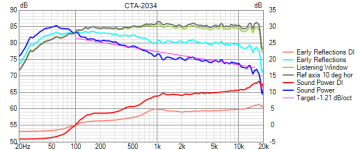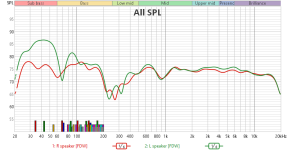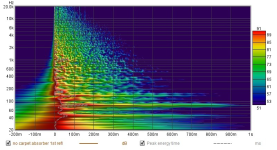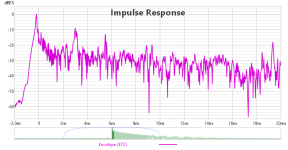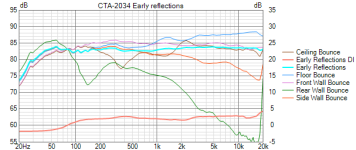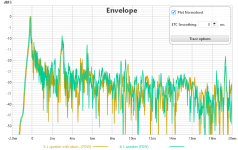The table left of the couch, that can cause distracting reflections.
Have you listened without the table placed there?
Have you listened without the table placed there?
Hi, yeah it could be front wall reflections that are particularly harmful, why not. Long post again, bit of a summary at first so skip few paragraphs if you will 🙂I don't know about significance of Griesinger works about what we are talking about, in fact i doubt about it. If we were talking about a defined listening location giving the effect, or takes within a given location of mic and room then yeah, but here it's not.
And my own experience shown it's unrelated either.
When mixing and mastering we usually do the 'listen from another room' trick. It gives a bit of perspective about the important things that must be heard from not optimal conditions/locations.
If mix is balanced you usually hear everything. Of course you don't have the stereo presentation.
From Vineeth comments i wonder if this 'effect' does not come from the lack of ER from the front wall. After all his other horn system doesn't seems to exhibit the same? And it's more conventional in the directivity behavior.
With meh and cardio there should be few front wall early reflections in the 200/1,5khz range ( where i suspect there is something at play).
The Griesinger stuff is basically that brain pays attention when it can detect a sound(source) from all noise around us. He explains the mechanism how this happens is auditory system detects periodic amplitude peaks that stick through above all the noise, all sounds that are around us constantly. Loud amplitude peaks mean phase is preserved, and it's sufficiently above all other sounds so the sound source is likely nearby and important to pay attention to. It can apparently track multiple sound sources and differentiating them by the fundamental period.
The periodic amplitude peaks happen when sound maintains original harmonics, which are all in phase every fundamental cycle and sum constructively. Auditory system "connects to" sound sources that stick out above the noise and makes your involuntary attention to the sound, which makes you ignore the noise, all other sounds that don't need attention. These are referred as foreground and background neural stream, but I just think them in context of perception, foreground stream is on top of your perception and background stream just gives room for it, is suppressed perceptually. Basically auditory system can provide clear sound to your perception, or not. I like to think this just how much processing power is allocated, background stream gets less than average and there is no detail perceptually, while foreground stream more than average. I like to think auditory system makes your perception, what we hear is not what enters the ear canal but what auditory system processed out of it, made into existence of conscious perception of it.
Now, you can take this basic concept to almost anything. Anything that reduces the amount of these amplitude spikes getting over noise could drop the sound out from the attention and give lesser weight in perception. Conversely, anything that helps would help make gain attention.
For example, if you have a recording of solo instrument like a singer, and good room acoustics, good speaker system and electronics, there shouldn't be any reason a well recorded and mixed piece would come out realistic, as it's harmonics weren't mingled too much in the process. Also the system wouldn't compress or raise the noise (in the room) so there is high chance the sound get's your max attention.
To ruin it, prevent attention and clear perception, you could either reduce the amplitude peaks auditory system connects to by multiple ways, or raise the noise (in the room) by multiple ways. This could happen in the electronics and in the speaker with simplest of concepts like distortion and group delay. It could also be hampered by loud early reflections or flutter echo in the room, background noise, or even by listening a mono signal from two speakers and not listening equidistant to both. Having speakers out of balance, and so on. But it could have happened also in the recording and production process of the recording. For example, if you introduce a dense mix of heavy guitar with the solo vocal it might be hard to get the singer cut through as they introduce a lot of noise for auditory system to latch on the vocal amplitude spikes. Snare cuts through, thats a spike, live snare so much so it makes eyes blink. A mix could be ruined in this regard by over processing introducing phase shifts here and there, and even with overall suboptinal balancing, arrangement, and so on.
So, it's a good test listen in other room to feel whether you can still get the important stuff through from the mix I think. It likely tells also about how well room acoustics and playback system plays together, if harmonics were preserved and noise stayed relatively low for the part it matters.
Ok this is likely oversimplification of things and considering just one aspect of sound, but I think there is something fundamental with this idea in general, how auditory system affects perception, the Griesinger stuff. At least it's a fun tool to use trying to understand these various aspects of perceived sound and explains a lot of things nicely 🙂 So, improve all and any aspects of a system and the sound should get more attention grabbing. If one doesn't like that kinda sound, then perhaps leave some "issues" in to prevent the brain to connect too much. Changing listening distance is great simple way to actively adjust this. Ok, sorry about the millionth very long post about the same old thing 😀 Anyway, writing this to get some knowledge out to get new generated in the community, to be able to soak that back in.
Last edited:
@JanRSmit: That table had not been there whenever I had been listening to music. It was just that yesterday while i took the pics it was there.. 🙂
@tmuikku: Thanks a lot for elaborating on the Greisinger stuff.. 🙂
To summarise, my wife has not liked the sound of my horn-based speakers (though she likes its looks) 🙂
And my friend who commented that it was bit too much has not listened to any proper hifi speakers except a pair of Q acoustics 2020i.. He has just been using bose Bluetooth speakers and home theatres.. So I thought that it is just a "getting accustomed to a new presentation of sound" adjustment issue w.r.t his comments.
I will take some MLP measurements and post it when i get time and check if we can see something special w.r.t enhanced clarity or the tiny blur in bass notes in that I observed..
@tmuikku: Thanks a lot for elaborating on the Greisinger stuff.. 🙂
To summarise, my wife has not liked the sound of my horn-based speakers (though she likes its looks) 🙂
And my friend who commented that it was bit too much has not listened to any proper hifi speakers except a pair of Q acoustics 2020i.. He has just been using bose Bluetooth speakers and home theatres.. So I thought that it is just a "getting accustomed to a new presentation of sound" adjustment issue w.r.t his comments.
I will take some MLP measurements and post it when i get time and check if we can see something special w.r.t enhanced clarity or the tiny blur in bass notes in that I observed..
A table like that will surely make measurable ripples in SPL, but at least I can't hear them at home. In general, modern measurements are too accurate, our two ears and brains do lots of smoothing and phase reconstruction! Even REW's psychoacoustic smoothing is too little at least for me. I almost always sit behind the mic when doing measurement sweeps, and rarely detect spl jumps.
It is known that some people are hypersensitive to sounds, visual, skin sense or other neural stimulation. Obviously their brains cannot process, filter and analyze important info from noise garbage, like tmuikku explained in his previous post.
ps. I also find deep horns too precise when at spot, and loss of treble is obvious when off-spot.
It is known that some people are hypersensitive to sounds, visual, skin sense or other neural stimulation. Obviously their brains cannot process, filter and analyze important info from noise garbage, like tmuikku explained in his previous post.
ps. I also find deep horns too precise when at spot, and loss of treble is obvious when off-spot.
Last edited:
I took measurements of each speaker from MLP using my Isemcon EMX-7150 mic with 90-degree cal file at the position where my head/ears would be during usual listening. The room height is 2.9m. My location is about 2.2m away from each speaker.
L speaker is the one on the left side of the pic
R speaker is the one on the right side of the pic

Quasi anechoic measurement based graphs


Frequency response curves at MLP for both speakers (with no additional EQ other than crossover)

The same graph with 5 cycle FDW (frequency-dependent windowing)

The L speaker gets more boundary reinforcement at low bass than the R speaker due to its corner placement.
That 88Hz peak is a usual problematic room mode which used to EQ down (but not yet done on this one since I haven't heard the problem caused by it yet)
The region in between 200 to 300 Hz seems to be the most affected by reflections followed by the 900Hz region which sees a 4dB ish dip (right in the crossover region).
Let me take the L speaker and model the proximity to boundaries based on actual tape measurements to each boundary

Predicted in room response based on this (orange curve) and comparing with actual FDW edmeasurement from MLP


Wow.. So all the reflections combined is wrecking havoc in the 200 to 300 Hz region and the 900Hz region 😀
Now Let's look at the approx contribution of each reflection
1. Front wall alone

It looks mild
2. Front wall + Left wall

The 200Hz reflection problem is worth taking care of now.. 😀
3. Front wall + Left wall +Ceiling

4. All major reflections combined

So it looks like the floor needs thicker carpet and front wall and left wall needs some heavy attenuation (aiming at the 200Hz to 300 Hz region) and/or some more directivity in the 200 to 300Hz region (which I don't know how practical it will be)
But what will that do to the overall decay spectrum?
Spectrogram

For comparison, here is a spectrogram of the 3way using the Satori woofers + SB15CAC +SB26CDC in our earlier house (with the same carpet and extra 2 8inch thick 8 ft x 2ft broadband absorption panels nearby at first reflection points) 😀

ETC showing the arrival of the major reflections at 3ms & 5.5ms

L speaker is the one on the left side of the pic
R speaker is the one on the right side of the pic
Quasi anechoic measurement based graphs
Frequency response curves at MLP for both speakers (with no additional EQ other than crossover)
The same graph with 5 cycle FDW (frequency-dependent windowing)
The L speaker gets more boundary reinforcement at low bass than the R speaker due to its corner placement.
That 88Hz peak is a usual problematic room mode which used to EQ down (but not yet done on this one since I haven't heard the problem caused by it yet)
The region in between 200 to 300 Hz seems to be the most affected by reflections followed by the 900Hz region which sees a 4dB ish dip (right in the crossover region).
Let me take the L speaker and model the proximity to boundaries based on actual tape measurements to each boundary
Predicted in room response based on this (orange curve) and comparing with actual FDW edmeasurement from MLP
Wow.. So all the reflections combined is wrecking havoc in the 200 to 300 Hz region and the 900Hz region 😀
Now Let's look at the approx contribution of each reflection
1. Front wall alone
It looks mild
2. Front wall + Left wall
The 200Hz reflection problem is worth taking care of now.. 😀
3. Front wall + Left wall +Ceiling
4. All major reflections combined
So it looks like the floor needs thicker carpet and front wall and left wall needs some heavy attenuation (aiming at the 200Hz to 300 Hz region) and/or some more directivity in the 200 to 300Hz region (which I don't know how practical it will be)
But what will that do to the overall decay spectrum?
Spectrogram
For comparison, here is a spectrogram of the 3way using the Satori woofers + SB15CAC +SB26CDC in our earlier house (with the same carpet and extra 2 8inch thick 8 ft x 2ft broadband absorption panels nearby at first reflection points) 😀
ETC showing the arrival of the major reflections at 3ms & 5.5ms
Attachments
Last edited:
It might damp the high frequencies too much if i use more absorption in this room
In this situation it looks like the best solution is to have wider directivity speakers/top module than what I have and then treat the room how much ever can be done.. 🙂
Sort of reinforces Kimmosto's general recommendation about wider radiating controlled directivity speakers and appropriate room treatment being a better solution for good sound.. 🙂
In this situation it looks like the best solution is to have wider directivity speakers/top module than what I have and then treat the room how much ever can be done.. 🙂
Sort of reinforces Kimmosto's general recommendation about wider radiating controlled directivity speakers and appropriate room treatment being a better solution for good sound.. 🙂
Last edited:
Hmm. Not sure it's this easy ime.
It depend in what you can tolerate as "appropriate room treatment".
If we take some well known wide radiating controlled directivity loudspeakers like ATC and you take a look at what is implemented in recent control room's design to control them... it is pretty extreme for a domestic room!
I've been sitted in front of something like this for 2 years and can tell it's not my thing at all, despite all the quality the loudspeaker have.
In the end it'll depend of your preferences about rendering too.
It depend in what you can tolerate as "appropriate room treatment".
If we take some well known wide radiating controlled directivity loudspeakers like ATC and you take a look at what is implemented in recent control room's design to control them... it is pretty extreme for a domestic room!
I've been sitted in front of something like this for 2 years and can tell it's not my thing at all, despite all the quality the loudspeaker have.
In the end it'll depend of your preferences about rendering too.
I think I might have got a clue regarding the blurred bass lines that I was commenting about earlier.. 😀

Comparing with the below pic (don't know if this is exactly right but seems to correlate somewhat with perception)

That 200-300 Hz region 10ish dB wide dip & delayed energy filling that gap might be contributing to that perception.. 🙂
Maybe the below is the reason for the feeling of a tiny bit less treble with the speakers

So I thought about what to do to design a speaker for this room based on the reflection attenuation.
I need bit more treble energy & need to reduce some of the strength of first reflections.
So I again went back to the Purifi + SB26CDC tweeter on waveguide+dual 15inch bass module configuration & added some absorption on the floor and walls
tweeter in waveguide + purifi mid on top of it in a 35cm wide cabinet. BEM sim + Baffle diffraction sim of mis based curves are used to get the below speaker's overall responses




Below 100Hz is anyway going to be controlled by room. But the 200Hz to 1kHz region might be better compared to the current situation shown below

Ceiling absorption might help much more like shown below but that is not viable

But now I might be able to afford that strategically placed little extra bit of absorption in the room because of the more energy sprayed into room by the wide radiating tweeter.. 🙂
Comparing with the below pic (don't know if this is exactly right but seems to correlate somewhat with perception)
That 200-300 Hz region 10ish dB wide dip & delayed energy filling that gap might be contributing to that perception.. 🙂
Maybe the below is the reason for the feeling of a tiny bit less treble with the speakers
So I thought about what to do to design a speaker for this room based on the reflection attenuation.
I need bit more treble energy & need to reduce some of the strength of first reflections.
So I again went back to the Purifi + SB26CDC tweeter on waveguide+dual 15inch bass module configuration & added some absorption on the floor and walls
tweeter in waveguide + purifi mid on top of it in a 35cm wide cabinet. BEM sim + Baffle diffraction sim of mis based curves are used to get the below speaker's overall responses
Below 100Hz is anyway going to be controlled by room. But the 200Hz to 1kHz region might be better compared to the current situation shown below
Ceiling absorption might help much more like shown below but that is not viable
But now I might be able to afford that strategically placed little extra bit of absorption in the room because of the more energy sprayed into room by the wide radiating tweeter.. 🙂
It is often forgotten that cardioid style radiation patterns do nothing to reduce sound towards the side walls and SBIR dips from them are just as bad as any other speaker.
The left speaker being tucked in the corner is always going to be tricky. You are also getting a low bass boost on this one side. Taking this down will also help to rebalance the sound. Too much bass or not enough treble sounds very similar.
An axisymmetric waveguide can always benefit from ceiling absorption. Ceiling reflections are quite damaging to perception. Making the waveguide asymmetric is a double edged sword if trying to reduce ceiling reflections, is there enough directivity at the ceiling bounce frequency range to have a useful effect?
I don't know if you have any placement flexibility but on the left some dips are exaggerated by having the same distance from side wall to rear wall. You can experiment virtually with Vituix to see if there is a practical placement that gives less interference. This is all about distances so for this sort of thing the basic function in Vituix works quite well.
Kimmo is advising for the fix to be in the room and acoustics, not in the speaker through high directivity. If you go with low directivity but still don't fix the placement or the room, it will not get better.
The left speaker being tucked in the corner is always going to be tricky. You are also getting a low bass boost on this one side. Taking this down will also help to rebalance the sound. Too much bass or not enough treble sounds very similar.
An axisymmetric waveguide can always benefit from ceiling absorption. Ceiling reflections are quite damaging to perception. Making the waveguide asymmetric is a double edged sword if trying to reduce ceiling reflections, is there enough directivity at the ceiling bounce frequency range to have a useful effect?
I don't know if you have any placement flexibility but on the left some dips are exaggerated by having the same distance from side wall to rear wall. You can experiment virtually with Vituix to see if there is a practical placement that gives less interference. This is all about distances so for this sort of thing the basic function in Vituix works quite well.
Kimmo is advising for the fix to be in the room and acoustics, not in the speaker through high directivity. If you go with low directivity but still don't fix the placement or the room, it will not get better.
And now when you have house full of speakers - and four boxes of potential subwoofers you could try multisub approach...
--->>> Harman Subwoofers: Optimum number and Locations
--->>> Harman Subwoofers: Optimum number and Locations
I will try to pull out the speaker more into the room. This tends to reduce the bass boost for that speaker.The left speaker being tucked in the corner is always going to be tricky. You are also getting a low bass boost on this one side. Taking this down will also help to rebalance the sound. Too much bass or not enough treble sounds very similar.
I will also check out what happens to the treble with this change.
With my current speaker, the spinorama ceiling bounce seem to be affecting the most around the 800 to 900 Hz regionAn axisymmetric waveguide can always benefit from ceiling absorption. Ceiling reflections are quite damaging to perception. Making the waveguide asymmetric is a double edged sword if trying to reduce ceiling reflections, is there enough directivity at the ceiling bounce frequency range to have a useful effect?
This also correlates with the 4-5 dB dip I have in the same region
For the smaller purifi mid-waveguide speaker top module (in future plans) with elliptical waveguide, the ceiling bounce-related effects seem to be milder and more spread out from 400 to 1.8kHz region with shallow slopes on the 15PR400 & the purifi as shown by the brown curve below.
Separating the midrange from the woofer with the woofer closer to the floor & the mid relatively higher up seems to make the effects of the ceiling bounce mild without any treatment
I tried that and this is the best I could do with practical placement options for the current speaker in the room.I don't know if you have any placement flexibility but on the left some dips are exaggerated by having the same distance from side wall to rear wall. You can experiment virtually with Vituix to see if there is a practical placement that gives less interference. This is all about distances so for this sort of thing the basic function in Vituix works quite well.
Bascially pulling out the speaker into the room will alter the distances to the front & left walls and distance to MLP.
Slightly altering the toe along with that and adding some carefully placed absorption gives the below.
This above one looks relatively milder but more spread out compared to current situation shown below
WIth some ceiling treatment, it can be like this even 🙂
Attachments
@Sasha KC83: I even have plans to try out double bass array.. 😀
Probably untill I get kicked out of the house.. 😛
Probably untill I get kicked out of the house.. 😛
Now I know how these estelon speakers can potentially be good in terms of floor and ceiling bounce perspective.. 😀

With minimal rounded baffles all around the mid and tweeter and more baffle area around the bass units already incorporated into the design, I think this can be made into a really good speaker if they want to.. 😀
With minimal rounded baffles all around the mid and tweeter and more baffle area around the bass units already incorporated into the design, I think this can be made into a really good speaker if they want to.. 😀
With the speaker pulled out a little there is space that you could use to place some absorbers in. Having less deep dips spread out will make the absorber more effective.Slightly altering the toe along with that and adding some carefully placed absorption gives the below.
This stuff seems quite interesting with better low frequency performance than Basotect, might be worth checking if it is available near you
https://www.soundblock.com.au/sound-absorbers/stratocell-whisper
With my current speaker, the spinorama ceiling bounce seem to be affecting the most around the 800 to 900 Hz region
...
This also correlates with the 4-5 dB dip I have in the same region
This can be easily treated with basotect on ceilling.
10cm with some centimeters gap should kill the reflection applied RFZ way ( the way it's done in a Reflection Free Zone, area treated abit wider than the first reflection area).
For the smaller purifi mid-waveguide speaker top module (in future plans) with elliptical waveguide, the ceiling bounce-related effects seem to be milder and more spread out from 400 to 1.8kHz region with shallow slopes on the 15PR400 & the purifi as shown by the brown curve below.
Separating the midrange from the woofer with the woofer closer to the floor & the mid relatively higher up seems to make the effects of the ceiling bounce mild without any treatment
Yes but even if it's milder it will happen on a wider range so might be more noticable. Not convinced? Try a high Q boost on a signal and try a low Q boost of same amount/freq. Which one is more readily heard?
I tried that and this is the best I could do with practical placement options for the current speaker in the room.
Bascially pulling out the speaker into the room will alter the distances to the front & left walls and distance to MLP.
Slightly altering the toe along with that and adding some carefully placed absorption gives the below.
View attachment 1392432
This is way better and will be far less noticable than a big notch as you have atm.
This isn't different than what MTM achieve wrt floor bounce: the different pathlength give smaller notch more widely separated. Overall our brain integrate this better.
When you talk about absorbtion, i'm curious: 200/300hz is borderline in bulkyness. To be effective if located on wall we talk about 10cm depth panel with a 20cm gap to wall iirc ( rockwooll 'standard' Early Reflection treatment kind of panels).
What are you thinking about exactly Vineeth ?
Thanks for these suggestions @krivium.
I am not able to do anything on the ceiling because of the rented accommodation and not having permission to drill anywhere in that room.
Regarding the left wall, I have these 8ft x 2ft x 8inch thick Absorption panels, which I was thinking about using on the left wall (actually a big glass window covered by curtains and opens into a balcony). I also have 10cm thick 4ft x 2ft basotect panels lying around.
Since these panels are movable, maybe I will be able to convince people at home that I need it at first reflection point, at least while I am listening to music.. 😀

The front wall is more of a bigger problem because of the big TV screen there, otherwise, I could have put some kind of absorption material there.

I tried to find out the material that @fluid suggested above.
The closest I could find was https://www.auralexchange.com/product/nankarrow-geohive-honeycomb-acoustic-panels/
It looks very similar, but may not exactly be the same thing in terms of absorption capability.
So, in general, I am just confused about what to do next w.r.t treating these "problems".. 😀 😀
This is all w.r.t left side speaker (floor reflection at 3ms & another major reflection, probably combined effect of walls at 5.5ms).

The right-side speaker is more problem-free because the nearest wall is 3+ m away and I just have to increase the absorption on the floor. In the first 20ms, the major first reflection comes around 3ms from the floor. everything else is at or below -20dB compared to the main peak.

I am not able to do anything on the ceiling because of the rented accommodation and not having permission to drill anywhere in that room.
Regarding the left wall, I have these 8ft x 2ft x 8inch thick Absorption panels, which I was thinking about using on the left wall (actually a big glass window covered by curtains and opens into a balcony). I also have 10cm thick 4ft x 2ft basotect panels lying around.
Since these panels are movable, maybe I will be able to convince people at home that I need it at first reflection point, at least while I am listening to music.. 😀
The front wall is more of a bigger problem because of the big TV screen there, otherwise, I could have put some kind of absorption material there.
I tried to find out the material that @fluid suggested above.
The closest I could find was https://www.auralexchange.com/product/nankarrow-geohive-honeycomb-acoustic-panels/
It looks very similar, but may not exactly be the same thing in terms of absorption capability.
So, in general, I am just confused about what to do next w.r.t treating these "problems".. 😀 😀
This is all w.r.t left side speaker (floor reflection at 3ms & another major reflection, probably combined effect of walls at 5.5ms).
The right-side speaker is more problem-free because the nearest wall is 3+ m away and I just have to increase the absorption on the floor. In the first 20ms, the major first reflection comes around 3ms from the floor. everything else is at or below -20dB compared to the main peak.
Last edited:
Working on SBIR as fluid describes, absorption to the left of the speaker that works at the problem frequencies (SBIR and to a lesser degree modal (takes a lot of absorption to have a big effect on room modes)), topped off by multiple subs with parametric EQ (min phase, cuts only- decreases both fr peaks and their decay) at the lowest room modes not covered by the amount of absorption you are able to achieve practically, and I bet you will be amazed. You have several incredible speakers built; I am confident you would be amazed hearing them in a more optimal acoustic and be able to really understand the pros and cons of the different directivity patterns of your various designs (this would be a very interesting datapoint for all of us).
Re. absorptive materials, this modeler is good. Main parameter for the material is gas flow resistivity (gfr). After that it is simply thickness +/_ an air gap. There is a thread on gearspace.com that has a long thread with an Excel sheet on the gfr of commonly available materials. I think Basotect is 10,000 rayls(?), but don't quote me. In general, the thicker you are able to go, the lower the GFR.
http://www.acousticmodelling.com/
Bill
Re. absorptive materials, this modeler is good. Main parameter for the material is gas flow resistivity (gfr). After that it is simply thickness +/_ an air gap. There is a thread on gearspace.com that has a long thread with an Excel sheet on the gfr of commonly available materials. I think Basotect is 10,000 rayls(?), but don't quote me. In general, the thicker you are able to go, the lower the GFR.
http://www.acousticmodelling.com/
Bill
As an experiment, I pulled out the speakers as mentioned in previous posts and put that broadband absorption panel near the first reflection point of the L speaker

Here is how the response looks like with and without absorber

Effect of absorption on left wall & speaker placement changes

VituixCAD prediction

Now it has become a single higher Q dip compared to the dual lower Q dips without absorption
Impact on ETC

Spectrogram with & without absorber & placement change


With absorber, above 8kHz, there is loss of energy, below that there is ever so slightly more energy down to 600ish Hz.
The delayed energy pattern in the 200 to 600Hz region also seems to have changed..
Here is how the response looks like with and without absorber
Effect of absorption on left wall & speaker placement changes
VituixCAD prediction
Now it has become a single higher Q dip compared to the dual lower Q dips without absorption
Impact on ETC
Spectrogram with & without absorber & placement change
With absorber, above 8kHz, there is loss of energy, below that there is ever so slightly more energy down to 600ish Hz.
The delayed energy pattern in the 200 to 600Hz region also seems to have changed..
Attachments
Last edited:
This-some aspects improving while others become more defined and perhaps look worse, is fairly common in this process. 1/4 wavelength at ~210 Hz is ~ 0.4 meters. I wonder what the height of your woofer is above the floor.....perhaps the dreaded floor bounce.... You just(!) need to add another below the current one as a .5 way...
@vineethkumar01 Have your ever tried tilting the SPL like 1db-1.2db an octave? A flat response can sound hot. Maybe it is already at your preferred setting.
I tried searching this thread for the word "tilt" but it has not been mentioned for some time.
I tried searching this thread for the word "tilt" but it has not been mentioned for some time.
- Home
- Loudspeakers
- Multi-Way
- A 3 way design study
